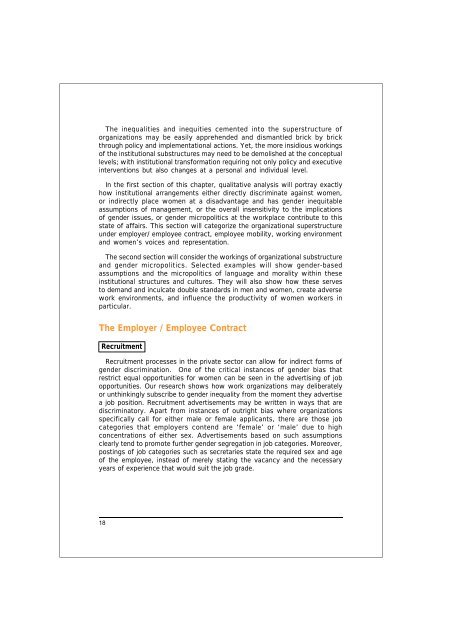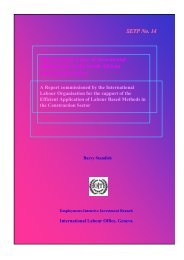Beyond Glass Ceilings and Brick Walls - International Labour ...
Beyond Glass Ceilings and Brick Walls - International Labour ...
Beyond Glass Ceilings and Brick Walls - International Labour ...
Create successful ePaper yourself
Turn your PDF publications into a flip-book with our unique Google optimized e-Paper software.
The inequalities <strong>and</strong> inequities cemented into the superstructure of<br />
organizations may be easily apprehended <strong>and</strong> dismantled brick by brick<br />
through policy <strong>and</strong> implementational actions. Yet, the more insidious workings<br />
of the institutional substructures may need to be demolished at the conceptual<br />
levels; with institutional transformation requiring not only policy <strong>and</strong> executive<br />
interventions but also changes at a personal <strong>and</strong> individual level.<br />
In the first section of this chapter, qualitative analysis will portray exactly<br />
how institutional arrangements either directly discriminate against women,<br />
or indirectly place women at a disadvantage <strong>and</strong> has gender inequitable<br />
assumptions of management, or the overall insensitivity to the implications<br />
of gender issues, or gender micropolitics at the workplace contribute to this<br />
state of affairs. This section will categorize the organizational superstructure<br />
under employer/ employee contract, employee mobility, working environment<br />
<strong>and</strong> women’s voices <strong>and</strong> representation.<br />
The second section will consider the workings of organizational substructure<br />
<strong>and</strong> gender micropolitics. Selected examples will show gender-based<br />
assumptions <strong>and</strong> the micropolitics of language <strong>and</strong> morality within these<br />
institutional structures <strong>and</strong> cultures. They will also show how these serves<br />
to dem<strong>and</strong> <strong>and</strong> inculcate double st<strong>and</strong>ards in men <strong>and</strong> women, create adverse<br />
work environments, <strong>and</strong> influence the productivity of women workers in<br />
particular.<br />
The Employer / Employee Contract<br />
Recruitment<br />
Recruitment processes in the private sector can allow for indirect forms of<br />
gender discrimination. One of the critical instances of gender bias that<br />
restrict equal opportunities for women can be seen in the advertising of job<br />
opportunities. Our research shows how work organizations may deliberately<br />
or unthinkingly subscribe to gender inequality from the moment they advertise<br />
a job position. Recruitment advertisements may be written in ways that are<br />
discriminatory. Apart from instances of outright bias where organizations<br />
specifically call for either male or female applicants, there are those job<br />
categories that employers contend are ‘female’ or ‘male’ due to high<br />
concentrations of either sex. Advertisements based on such assumptions<br />
clearly tend to promote further gender segregation in job categories. Moreover,<br />
postings of job categories such as secretaries state the required sex <strong>and</strong> age<br />
of the employee, instead of merely stating the vacancy <strong>and</strong> the necessary<br />
years of experience that would suit the job grade.<br />
18
















